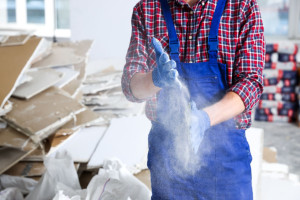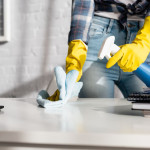 When drywall was invented in 1916, it wasn’t an immediate hit. At the time, plaster and wood walls were more popular, but by the 1940s, drywall became more popular because it was cheaper, lighter, and easier to use. It’s now one of the most predominant construction materials, with over 20 billion square feet manufactured each year in the United States, according to the Gympsum Association.
When drywall was invented in 1916, it wasn’t an immediate hit. At the time, plaster and wood walls were more popular, but by the 1940s, drywall became more popular because it was cheaper, lighter, and easier to use. It’s now one of the most predominant construction materials, with over 20 billion square feet manufactured each year in the United States, according to the Gympsum Association.
Drywall is used in the construction of walls, and it’s made using gypsum. This material is non-combustible, so it’s ideal for home and business construction, especially when refined into a powder between two paperboards to form drywall. It’s easy to install, paint, and remove, which is why it’s so prevalent in construction. So it’s likely that if you’re planning a renovation, it’s expected that you will deal with drywall in some way.
Removing drywall is pretty easy. You can take a hammer to a wall between studs and quickly break it up. But as most construction professionals will tell you, drywall is very dusty. When removing it, you’re likely to create a significant amount of dust, and the dust from drywall is also very fine, so it quickly settles on everything on the project site. Drywall dust is, unfortunately, also easily tracked from one area to the next. This can make the clean-up process very burdensome.
Another drawback of cleaning up drywall dust and remnants is that it’s very soluble in water. The gypsum and paperboard in the drywall can form a thick paste that easily sticks to everything and can be difficult to remove. The drywall mud used to put up and connect the drywall can also cause a big mess and make it difficult to remove, like wet drywall dust. So it’s essential that you clean drywall materials and dust up the right way. Here are some tips from the Spruce on how to clean up drywall dust:
- Remove the dust with a soft brush or broom. You’ll need to ensure you wear a mask, glasses, and PPE so you don’t inhale the dust as you disturb it. You can also use a shop vacuum or one with a HEPA filter.
- Use a slightly damp cloth to remove excess dust. Ensure it’s not too wet, or you will damage the drywall beneath or cause the dust to gum up and form into a paste. Sponges specifically designed for drywall are also helpful for this task.
- Try a tack cloth, too. Tack cloth is an excellent tool for dust removal. It’s thin, like cheesecloth or gauze, but it has beeswax embedded into the fibers. This makes it great at picking up fine dust. Just make sure you don’t push too hard and get wax stuck on the wall.
- You’ll need warm water if the drywall dust has hardened to the surface. It will help dissolve the caked-on dust or mud, but you must wipe it off quickly before it dries again. Change your water frequently during this process so you don’t transport the dissolved dust and mud onto other surfaces as you wipe things down.
Drywall dust is a huge pain during the renovation process. It gets everywhere, and it’s not the easiest thing to clean. You have to be careful not to get things too wet during clean-up. Damp drywall will quickly begin to mold and have to be replaced. So, if you’re planning a renovation and drywall will be removed or installed, let us clean things up for you. Our post-construction team has the skills and tools to remove every last spec of drywall dust!








